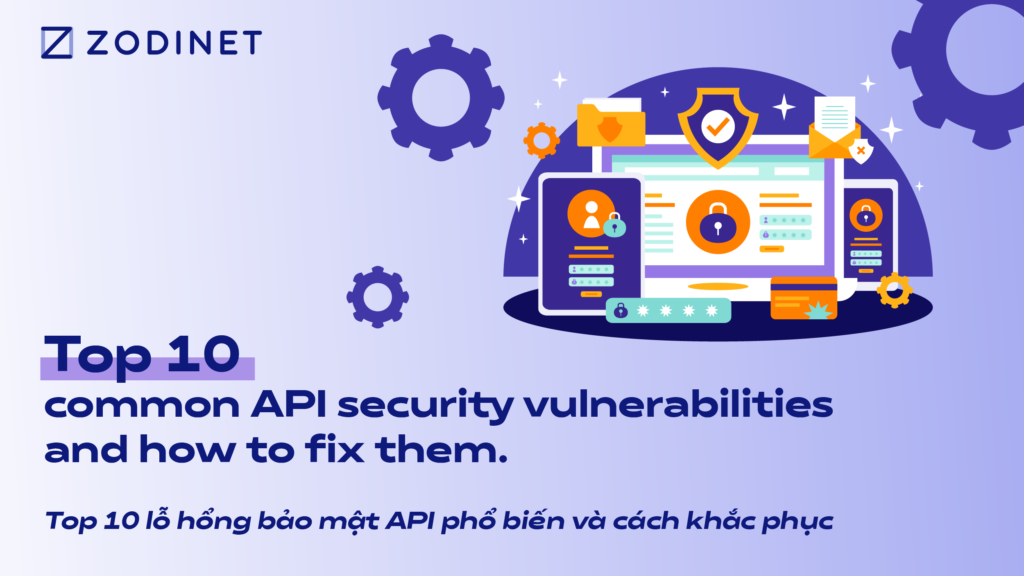
1. API and its importance
What is API?
API (Application Programming Interface) is a set of definitions and protocols that computer programs can use to communicate and interact with each other. It allows developers to access the functions, services, or data of an application, service, or system without needing to know the details of how they are implemented. APIs can be used to integrate applications with each other, access data from web services, or create client applications that use remote services.
The Importance of API Security
API security is one of the top priorities for product developers for the following reasons:
- Protecting sensitive data
- Preventing unauthorized access
- Defending against DDoS attacks
- Ensuring data integrity and authentication
- Complying with legal regulations
2. Top 10 Common API Vulnerabilities
Broken Object Level Authorization
Broken Object Level Authorization (BOLA) occurs when access controls to objects within an application are not properly enforced or are insufficiently secure, allowing attackers to exploit vulnerable API endpoints by manipulating the object IDs sent in requests. This can lead to unauthorized disclosure of data, data loss, or data manipulation. In some cases, unauthorized access to objects can even result in the complete takeover of accounts.
Prevalence: High. This issue is extremely common in API-based applications because the server-side component often does not fully track the client’s state, instead relying heavily on parameters such as object IDs sent from the client to decide which objects to access.
Solutions to Prevent BOLA Vulnerabilities:
- Implement precise and sufficiently secure access controls for each object in the application
- Validate user permissions and verify the legitimacy of data modification requests
- Use random and unpredictable values as GUIDs for record IDs
Broken Authentication
Occurs when authentication and session management measures are not properly implemented. This allows attackers to bypass the authentication process and gain unauthorized access to user accounts, read their personal data, and perform sensitive actions on their behalf. Systems find it difficult to distinguish between the actions of an attacker and those of a legitimate user.
Broken Object Property Level Authorization
BOPA (Broken Object Level Authorization) occurs when access control to the properties of an object in an application is not properly implemented or sufficiently secure. This allows attackers to perform unauthorized actions on the properties of an object within the application. This can lead to unauthorized access, modification, or deletion of properties that the attacker is not allowed to access.
Solutions to Prevent BOPA Vulnerabilities:
- When exposing an object through an API endpoint, always ensure that users have the appropriate access rights to the object’s properties you are displaying.
- Avoid using generic serialization methods like
to_json()orto_string(). Instead, explicitly select the specific properties of the object that you want to return. - If possible, avoid automatically binding client input to internal objects or object properties (“mass assignment”).
- Only allow changes to the properties of an object that the client needs to update.
- Keep the data structure returned from the API endpoint minimal, based on business requirements/functionality.
Unrestricted Resource Consumption
Broken Function Level Authorization
Broken Function Level Authorization (BFLA) occurs when access control to the functions of an application is not properly implemented or sufficiently secure.
When BFLA vulnerability occurs, attackers can access, execute, or modify application functions without proper access or authorization. This can allow attackers to perform unauthorized actions or exploit administrative features or special access rights improperly.
To prevent BFLA vulnerabilities, developers need to:
- Verify and enforce access rights for each function of the application.
- Implement precise and secure access controls.
- Validate the legitimacy of function execution requests.
- Additionally, monitoring and detecting unauthorized activities or improper function executions are crucial steps to prevent BFLA vulnerabilities.
Unrestricted Access to Sensitive Business Flows
Unrestricted Access to Sensitive Business Flows (UASBF) is a security vulnerability in enterprise applications. It occurs when users have unrestricted or insufficiently secure access to sensitive business processes.
When UASBF occurs, attackers can access and perform unauthorized activities within critical business processes such as account management, payments, ordering, or handling sensitive information. This can lead to exposure of critical information, fraud, or negatively impact business operations and the organization’s reputation.
To prevent UASBF vulnerabilities, developers and system administrators need to:
- Establish and enforce strict access control policies.
- Implement appropriate access management practices.
- Monitor user activities to detect and prevent unauthorized access to sensitive business processes.
- Ensure data security and privacy to mitigate UASBF risks effectively.
These measures are essential for safeguarding sensitive business flows and maintaining the integrity of organizational operations and data privacy.
Server-Side Request Forgery
Server-Side Request Forgery (SSRF) vulnerability can occur when an API fetches remote resources without authenticating the URI provided by the user. This allows attackers to exploit the API to send requests to systems, even when those systems are protected by firewalls or VPNs.
When SSRF occurs, attackers can send requests from the server to chosen IP addresses, ports, and resources, including internal systems, offline servers, or other services. This can lead to sensitive information disclosure, denial-of-service (DoS) attacks, or exploitation of other vulnerabilities within the internal system.
So how do you prevent this issue?
- Isolate the resource fetching mechanism in your network: Typically, these features are meant to access resources from external sources rather than internal resources.
- Whenever possible, use an allow list:
- Remote users should download resources from (e.g., Google Drive, Gravatar, etc.).
- URL schemas and ports.
- Accepted media types for a specific function. Disable HTTP redirection.
- Use a validated and well-maintained URL parsing library to avoid issues caused by inconsistencies in URL parsing.
- Authenticate all customer-provided input data.
- Do not send raw responses to customers.
Security Misconfiguration
Occurs when the system configuration, server, application, or security components are not set up or configured correctly, leading to insecure settings and vulnerabilities that hackers can exploit.
Security misconfigurations not only expose sensitive user data but also details of the system that can lead to compromising the entire server.
To prevent Security Misconfiguration vulnerabilities, developers and system administrators need to establish and adhere to security guidelines, apply secure configurations to all components, regularly update and patch software and systems, validate configurations and runtime environments, and implement tight security management for systems and applications.
Improper Inventory Management
Improper Inventory Management is a vulnerability in the management and control of API endpoints. It occurs when the API storage process is not implemented correctly or lacks sufficient security measures, leading to loss, waste, and potential financial risks for the organization.
An API has a “documentation blind spot” if:
- The purpose of the API server is unclear and there are no clear answers to the following questions
- What environment is the API running in (e.g., production, test, development)?
- Who should have network access to the API (e.g., public, internal, partner)?
- What version of the API is running?
- There is no documentation or the current documentation is not updated.
- There is no downtime plan for each version of the API.
- The server repository is missing or out of date.
An API has a “data flow blind spot” if:
There is a “sensitive data flow” where the API shares sensitive data with third parties and
-
- No business justification or flow approval
- No inventory or flow visibility
- No deep visibility into what type of sensitive data is shared
Unsafe Consumption of APIs
Unsafe Consumption of APIs is a security vulnerability in the use of application programming interfaces (APIs). It occurs when an application fails to control or ensure the safety of its communication and use of APIs.
APIs can be vulnerable if they:
- Interact with other APIs over unencrypted channels;
- Do not properly validate and sanitize data collected from other APIs before processing or passing that data to downstream components;
- Follow redirects blindly;
- Do not limit the number of resources available to handle third-party service responses;
- Do not implement timeouts for interactions with third-party services;
How to Prevent Unsafe Consumption of APIs Errors:
- When evaluating service providers, assess their API security posture.
- Ensure all API interactions occur over secure communication channels (TLS).
- Always authenticate and properly sanitize data received from integration APIs before using them.
- Maintain a whitelist of integration APIs in well-known locations that may redirect your API to: do not blindly follow redirects.
API security is a key element in protecting data and maintaining system trust. Identifying and fixing common security vulnerabilities is an important step in preventing risks. Implementing modern security measures, regularly testing, updating, and complying with legal regulations helps protect systems from potential attacks. Investing in API security not only protects data, but also builds a safe and trustworthy online environment.
